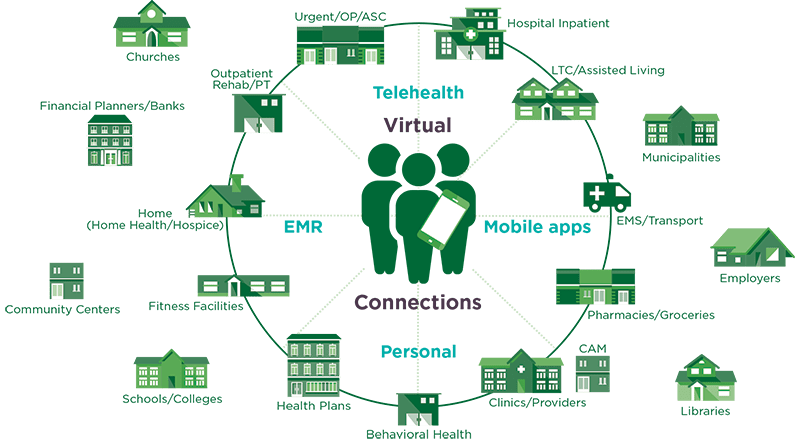Rural health systems are fertile grounds for innovation – that’s the consensus reached by healthcare executives at the Health:Further conference last month, and we couldn’t agree more. With declining populations compounded by challenges associated with provider shortages, governmental influences and rapidly advancing technologies, rural health systems should recognize and seize the opportunity to reinvent the way they deliver health to their communities.
As discussed in our blog last week on Advancing Rural Health, market forces are driving transformation in the strategies deployed by rural and critical access hospitals. My colleagues and I envision successful innovation taking shape through “lifecare,” a consumer-centric ecosystem that offers integrated health-related services across the full continuum of consumer needs.
To create this ecosystem, consumers and suppliers (including payers) of health and wellbeing services will connect on a platform. Companies such as Apple, Uber and Airbnb have successfully unlocked the power of platforms, according to Harvard Business Review’s article titled, Pipelines, Platforms and the New Rules of Strategy. “Platform businesses bring together producers and consumers in high-value exchanges,” explain the authors. “Their chief assets are information and interactions, which together are also the source of the value they create and their competitive advantage.”
With a platform strategy, everyone wins because decisions are made that encourage healthy lives. The strategy places the consumer at the center of the ecosystem, and products and services are rendered from expected and non-traditional entities, including healthcare disruptors. While healthcare disruptors may be viewed as threats when they enter the market, many are actually good sources of collaboration for the lifecare platform model. Rural communities can benefit from innovation that identifies and tracks how consumers will expect service and care in the future.
[bctt tweet=”With a platform strategy in #ruralhealth, everybody wins because the end result is a #lifecare ecosystem where better health flourishes.” username=”DobiesGroup”]
For rural hospitals and critical access hospitals, the platform acts as a hub, facilitating interactions through which consumers can actively and continuously engage in their health. The ideal environment allows competitors and community partners (e.g., public health departments, schools, fitness facilities, grocery stores, healthcare disruptors, etc.) to become collaborators, working together on behalf of the consumer. Public and private partnerships provide greater access to community-based life products and services such as healthy foods, fitness programs, health education, telehealth, digital health coaching and services borne from predictive analytics. Preventive health and wellness programs become more accessible and personalized, leading to increased engagement and utilization. The end result: an ecosystem where better health flourishes, benefiting everyone in the rural community.
Lifecare is a framework for creating a cohesive network that connects each consumer to the products, services, education and additional support needed for optimal individual health. Rural and critical access hospitals can and should take a more active role in facilitating optimal outcomes across a more unified and connected system. And those who embrace this level of innovation now have the greatest opportunity to emerge as local, regional and even national leaders who are authentically consumer-centric, catalyzing a movement toward a more meaningful impact on individual and population health.
Developing a lifecare platform strategy is complex but necessary, and the time to begin your planning is now. With the health industry’s rapid transformation into consumerism, population health, value-based reimbursement, rural and critical access hospitals that are slow to embrace a collaborative, consumer-centric lifecare model will get left behind.
Successfully creating your new business model design requires a firm commitment to strategic business planning, organizational readiness assessments, collaborative partnerships, cultural alignment, consumer engagement and brand authenticity. There is no universal approach – the scope and application can and will vary from one enterprise to the next, but all will have at least one common denominator: a consumer-centric ecosystem where partners share a vision for keeping people healthy throughout their lives.
At Dobies Health Marketing, we don’t just challenge rural health leaders to advance rural health in ways that elevate the overall health of the community – we offer a unique program to support it. We use our strengths in strategic marketing, branding and communications to position rural and critical access hospitals as catalysts for health in their local communities. We help define what an ecosystem might look like, one that places the consumer in the middle and then creates an environment around them where health will flourish. Lifecare is a shift from the traditional pipeline strategic planning to a platform model, and it opens new doors of opportunity to advance rural health.
Author’s Note: Thank you for reading this article, which is Part 2 of our series on Advancing Rural Health. I encourage you to dive into the rest of the series as well, which we are rolling out throughout September:
- Part 1 – Addressing Market Challenges: Pivoting to accommodate the rural market forces at play in order to sustain and improve health in your community
- Part 3 – Promoting the Value of Primary Care: The importance of reacquainting communities with the value of primary care
- Part 4 – Seven Steps to Service Line Marketing Strategy: A data-driven process to prioritize marketing dollars for service line growth
About the Author



